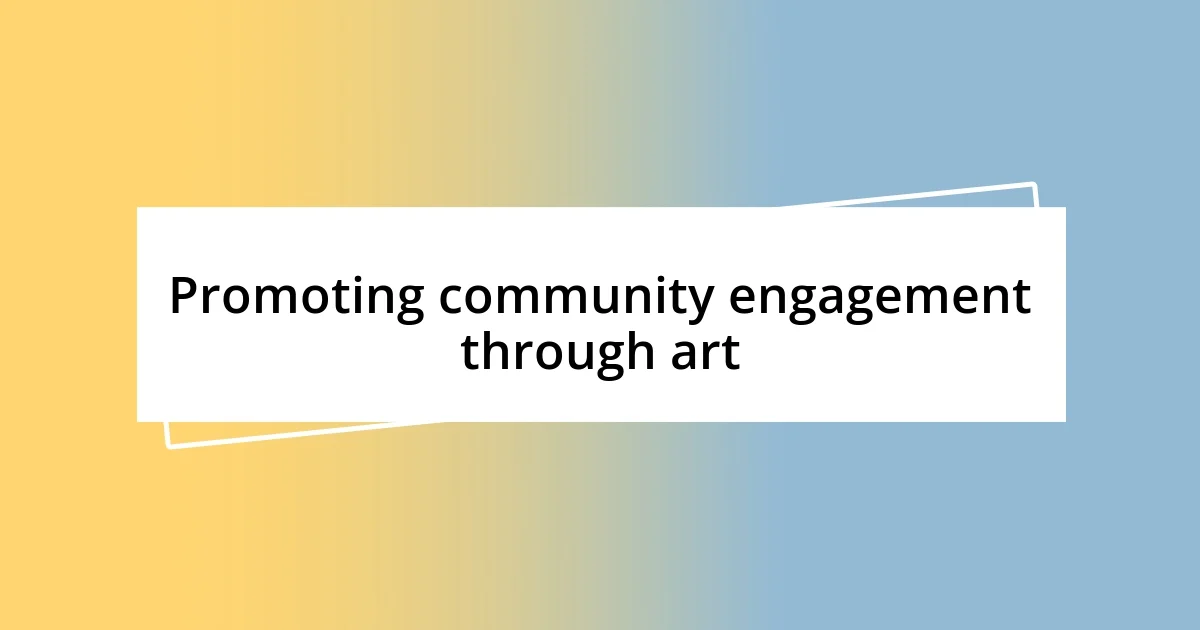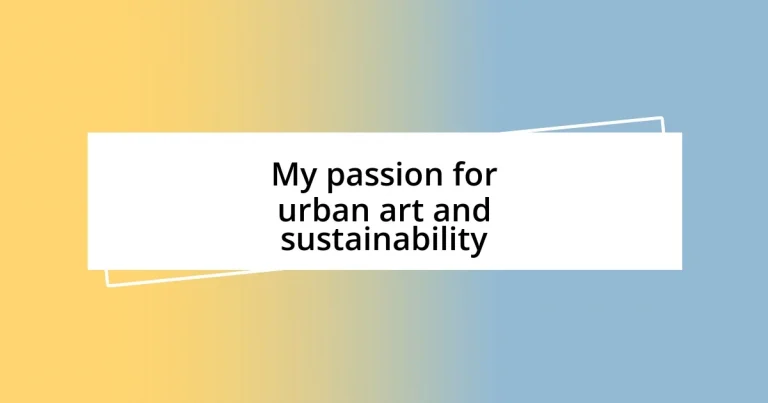Key takeaways:
- Urban art serves as a powerful tool for community expression, challenging societal norms and fostering dialogue about important issues.
- Techniques for sustainable urban art include using recycled materials, eco-friendly paints, and creating living walls to promote environmental awareness.
- Successful community engagement through art occurs via collaborative projects, storytelling, inclusivity, and hosting art-related events, strengthening community bonds.

Understanding urban art significance
Urban art carries immense significance, acting as a vibrant voice for communities often marginalized in mainstream culture. I remember walking through a city where murals transformed dull walls into stunning canvases, sparking conversations among locals. Didn’t that make you wonder how art can reflect the essence of a neighborhood and ignite pride among its residents?
What strikes me about urban art is its unique ability to tell stories that are just waiting to be heard. Think of that striking graffiti you pass by daily—how many narratives lie within those bold colors and intricate designs? It’s fascinating to realize that these artworks not only beautify spaces but also challenge societal norms and foster dialogue about pressing issues in a way that traditional art sometimes doesn’t.
Moreover, urban art acts as a catalyst for change, encouraging sustainability and social awareness. For instance, I once learned about a mural painted entirely with eco-friendly paints, inspiring others to consider their environmental footprint. How powerful it is when art is not just a visual experience but a movement pushing us to rethink our relationship with our environment!

Techniques for sustainable urban art
One of the groundbreaking techniques for sustainable urban art is the use of recycled materials. Artists creatively source items like scrap metal, old tiles, and discarded wood to create striking installations. I’ve seen a local artist transform a pile of broken pallets into an intricate outdoor sculpture—using what would otherwise be waste not only highlights resourcefulness but also reinforces a message of sustainability.
Another exciting approach is using eco-friendly paints and sprays. These products are often free from harmful chemicals, making them a safer choice for both artists and the environment. During a community art project, I participated in a mural workshop where we exclusively used plant-based paints. The colors were vibrant, and knowing we were contributing to a healthier ecosystem made the creative process even more fulfilling.
Additionally, living walls are an innovative technique that merges art with nature. By incorporating plants into urban designs, artists create dynamic green spaces that beautify neighborhoods while improving air quality. I remember attending an unveiling of a living wall in my city, where not only did it serve as a stunning backdrop for photos, but it also sparked conversations about urban biodiversity and the importance of green spaces in our daily lives.
| Technique | Description |
|---|---|
| Recycled Materials | Using scrap and discarded items to create art installations that emphasize resourcefulness. |
| Eco-Friendly Paints | Utilizing non-toxic paints that are safer for both artists and the environment. |
| Living Walls | Integrating plants into urban art, enhancing aesthetics while promoting biodiversity. |

Promoting community engagement through art
Engaging a community through art is one of the most rewarding experiences. I recall attending a local mural festival where not only did I witness artists at work, but I also saw residents actively participating. Children, parents, and artists came together to design and paint a vibrant mural that represented the neighborhood’s history. This hands-on involvement created a sense of ownership and connection, and watching the joy on everyone’s faces was truly heartwarming. It’s incredible how art can dismantle barriers and encourage collaboration.
To foster this engagement effectively, I believe several strategies can be beneficial:
- Collaborative Projects: Organizing workshops where community members can contribute to art pieces encourages teamwork.
- Storytelling: Art can incorporate local stories, allowing people to feel represented and valued.
- Inclusive Spaces: Creating opportunities for diverse voices to be heard through art can strengthen community bonds.
- Events and Festivals: Hosting events centered on art brings people together, sparking relationships and dialogue.
As I reflect on my experiences, it’s clear that the transformative power of art goes beyond aesthetics—it cultivates community spirit and unity in such a profound way.

Case studies of successful projects
One remarkable case study is the “Street Art for Mankind” initiative, which merges urban art with social causes. I remember being struck by the sheer impact of artists transforming walls into powerful messages against child trafficking. It’s inspiring to see how the creative community rallies together for a cause, making art a medium for advocacy. Seeing these murals in person, I couldn’t help but wonder how many lives were touched by the messages they conveyed.
In another instance, the “Reclaim the Streets” project revitalized neglected urban spaces in my city. Artists collaborated with residents to create murals that reflect local histories and identities. I was part of a workshop where we painted a vibrant mural illustrating our community’s stories. This experience went beyond just creating art; it fostered connections among neighbors who might not have interacted otherwise. I often think about how much community pride that mural instilled in everyone involved.
Additionally, the Living Walls initiative in Atlanta showcases how urban environments can be enhanced through art and nature. The integration of murals and greenery not only beautifies public spaces but also engages the community in maintaining these areas. I was lucky enough to witness a community plant day where we painted and planted together. It’s incredible to see how a blend of art and sustainability can cultivate a sense of responsibility and belonging. Have you ever felt that joy of transforming a space with a group of eager hands? It’s an experience that stays with you and reminds us of the power we hold to shape our surroundings.

Resources for urban artists
Urban artists often need a variety of resources to bring their visions to life. I remember my first time looking for supplies; I was overwhelmed by options and unsure where to start. Local art supply stores usually have a unique charm, offering not only materials but also knowledge through staff who can guide newcomers. I found that building relationships with these local shops opens up opportunities for discounts and access to exclusive workshops or events that help artists refine their skills.
In addition to traditional materials, digital resources are invaluable for today’s urban artists. I frequently turn to platforms like Skillshare or YouTube to learn new techniques and trends. I came across a fantastic series on graffiti artistry that completely shifted my approach. It’s fascinating how online communities can foster collaboration, letting artists share their work, seek feedback, and even find project partners across the globe. Have you considered joining an online forum or community? It could be the catalyst for your next artistic breakthrough.
Grants and sponsorships serve as crucial resources too. I vividly remember the thrill of applying for a grant from a local arts council to fund a community mural project. The process was daunting but ultimately rewarding, as it not only provided needed funds but also validated the project in the eyes of the community. Many organizations offer funding specifically for sustainable urban art initiatives, so keep an eye out! Even considering crowd-funding platforms can open doors to realizing ambitious projects—it’s amazing what collective support can achieve.














